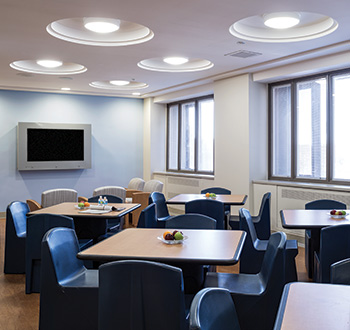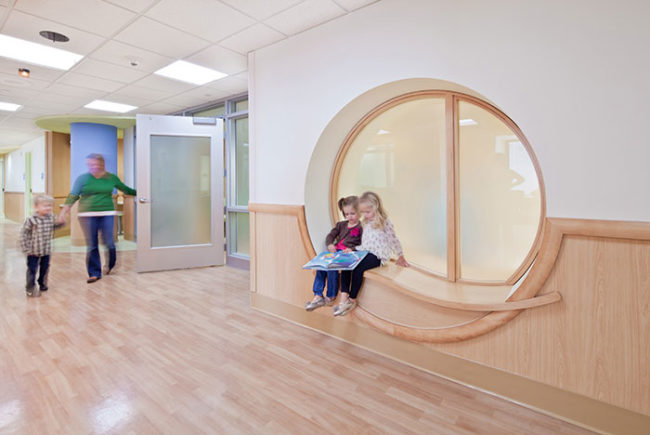 |
|
PHOTO BY PAUL WARCHOL This dining room is part of a new behavioral health care facility designed by the Behavioral Healthcare Architecture Group and located at Kingsbrook Jewish Medical Center in Brooklyn, N.Y. |
Behavioral health care facilities are intrinsically different from general hospitals in many ways.
For a start, the basic function of the patient room is different. In general hospitals, the patients spend the majority of their time seeing their doctors, receiving treatment, eating their meals and talking with visitors in their rooms. In behavioral facilities, all of these functions take place in other locations such as group rooms, day rooms, dining rooms and activity rooms, which do not exist in general hospitals.
Another significant difference is that general hospital patients typically are not considered to be suicidal. While all behavioral health patients are not suicidal, inpatient suicides are a continuing area of concern. Moreover, the rates are not declining despite concerted efforts to reduce them.
Patient-to-staff injuries also are significant issues in behavioral health facilities and not only result in significant workers’ compensation claims, but also impact staff retention and recruitment costs. These concerns require that furniture and equipment provided for these patients be vastly different from what is typically provided in general hospitals.
Perhaps it is not surprising, then, that regulatory requirements for behavioral health care facilities are much different from those written for general hospitals.
Regulatory differences
Codes, standards and references for behavioral health facilities contain much more emphasis on security and less on patient comfort. For instance, medical gases and nurse call systems are required at patient beds in general hospitals, but are specifically not required for behavioral health. Likewise, the requirement for privacy between beds in semiprivate medical patient rooms is also not required for behavioral health.
The emphasis on safety and security often can lead to the creation of an environment that looks and feels more like a prison than a hospital. Consequently, the various codes and regulations also have language that emphasizes that a therapeutic environment be provided that is “characterized by a feeling of openness with emphasis on natural light,” as noted in the Facility Guidelines Institute’s (FGI’s) Guidelines for Design and Construction of Health Care Facilities. While these may seem to be conflicting concepts, a well-designed behavioral health facility can accomplish all of these parameters.
Codes. A number of documents that provide detailed information regarding design and construction of psychiatric facilities are used to regulate design. Examples are the International Building Code family of documents and the National Fire Protection Association (NFPA) documents including, but not limited to, the NFPA 101 Life Safety Code.
The code documents include not only general requirements that apply to all health care facilities but specific requirements and exceptions that only apply to behavioral health facilities. These include allowing the locking of exit doors, limiting the opening size of operable windows, locking the fire extinguisher cabinets and fire alarm pull stations, among others.
The ability to lock exits falls into two categories commonly referred to as “fail-safe” and “fail-secure.” Fail-safe provides automatic unlocking of exits when the fire alarm system is activated, and fail-secure keeps the exits locked when the fire alarm system is activated until staff members unlock them.
Care should be exercised when interpreting code requirements for any given project. For example, the 2012 edition of NFPA 101 allows doors from patient rooms to corridors to have roller latches in lieu of “positive latching devices.” This was the standard 40 or 50 years ago before the codes began requiring positive latching for all corridor doors. Even though the current edition of the Life Safety Code allows roller latches, the Centers for Medicare & Medicaid Services (CMS), the Joint Commission and other agencies that have a strong say in these matters have not accepted roller latches for these doors. In such cases and possibly others, it is advisable to make sure that all authorities having jurisdiction (including local agency representatives) are in agreement before proceeding.
Standards. These documents provide detailed information regarding design and construction. Compliance with them is not necessarily legally required, but these standards are referenced in codes, laws and other regulations, and may be relied on by courts to determine the prevailing standard of care. They are developed by a large number of experienced individuals working together to form a consensus of minimum requirements.
One example is the FGI Guidelines. The 2014 edition has two volumes — the Guidelines for Design and Construction of Hospitals and Outpatient Facilities and the new Guidelines for Design and Construction of Residential Health, Care, and Support Facilities.
The FGI Guidelines is widely accepted as establishing the national standard of care for all types of health care facilities, including freestanding psychiatric hospitals, psychiatric units in general hospitals and a wide range of outpatient and emergency facilities that treat the mentally ill. It is referenced by the Joint Commission, many state laws and many court systems. In several states, the document is adopted by law and gains a status similar to a code. In other states, it is referenced or used as a template to create their own standards. In any case, following the requirements of this document provides owners and design professionals a more defensible position if an incident leads to legal action.
The central focus of psychiatric hospital-specific standards in the FGI Guidelines is in Chapter 25, which specifically addresses freestanding psychiatric hospitals. Other chapters refer to this for the basic issues or are referenced from this chapter for other specific exceptions.
This document gets very prescriptive regarding the size of patient rooms, maximum number of patients per room, location and quantity of patient bathrooms, and area of such common spaces as activity rooms, group rooms and dining rooms. For instance, seclusion rooms must be a specific size. Both the length and width can be no less than 7 feet nor more than 11 feet with 9-foot ceilings and provided at a ratio of one room per 24 beds. They also must be accessed through an anteroom and have a bathroom directly accessible from the anteroom. Other specific requirements regarding finishes, hardware, door sizes and door swing also are provided. Window systems, light fixtures, air grilles, furnishings, toilet accessories, finishes, door hardware and the therapeutic nature of the environment also are addressed.
The FGI Guidelines is revised on a four-year cycle and the 2014 edition was released last year. There are some significant changes in this edition from the 2010 edition. They include:
• Safety risk assessments are now required for all projects. Specific assessments for psychiatric patient injury and suicide prevention are required and discussed in section 1.2–3.6.
• The term “geriatric” has been removed from the formerly named “geriatric, Alzheimer’s and other dementia” units. This may be recognition that the lower end of age ranges of patients admitted to dementia units has been going down in recent years — it is important to treat the diagnosis regardless of the chronological age of the patient.
• Acoustic tile ceilings are no longer allowed in seclusion rooms, patient bedrooms, patient toilet rooms or patient bathing facilities.
• Built-in furniture no longer can have doors or drawers, and all open shelves must be fixed in place.
References. These are documents prepared by organizations to assist facilities and designers in understanding the unique differences inherent in behavioral health facilities, and suggestions of specific products that may be more appropriate for use in these facilities. Examples include:
• “Design Guide for the Built Environment of Behavioral Health Facilities,” published by the National Association of Psychiatric Health Systems (NAPHS).
• “Patient Safety Standards, Materials and Systems Guidelines,” published by the New York State Office of Mental Health (OMH).
• “Mental Health Facilities Design Guide,” published by the Department of Veterans Affairs (VA), Office of Construction & Facilities Management.
These documents, while similar in many ways, are also different. One of the differences is the intended audience. The NAPHS design guide is general in nature and attempts to illustrate the range of possible products and design philosophies that may be acceptable in various facilities depending on wide variances in patient populations, acuity, staffing patterns, culture and target market. The New York State OMH document specifically addresses what is allowable in the facilities owned and operated by the state. It includes suggestions of what is appropriate in other facilities in New York and may be applicable to facilities in other states as well. The VA document establishes criteria and specific limitations that are required for use within the VA system and also may be applicable to other behavioral health facilities.
All three documents should be reviewed to determine their applicability.
Taking care
The current state of codes, standards and references related to behavioral health care facilities still leaves designers dealing with a series of documents that may be contradictory and confusing.
Care in recognizing the differences between general hospitals and behavioral health facilities in all aspects of their space utilization, patient needs, and code and regulation requirements will result in a completed project that is safe, attractive, functional and compliant with all applicable requirements.
James M. Hunt, AIA, and William N. Bernstein, LEED AP, AIA, are founding partners of the Behavioral Healthcare Architecture Group, with offices in New York City and Topeka, Kan. Hunt also is co-author of the National Association of Psychiatric Health Systems’ “Design Guide for the Built Environment of Behavioral Health Facilities.” They can be reached at jim@bharchgroup.com and wb@bharchgroup.com, respectively.
Assessing psychiatric patient safety
The patient population being served and the patients’ level of suicidal ideation both must be evaluated to determine a level of risk that is acceptable for any psychiatric facility.
The level of concern for the safety of patients and staff due to the design of the built environment is not the same in all parts of a behavioral health unit or facility. The level of precautions necessary depends on the staff’s knowledge of the patient (i.e., the patient’s intentions regarding self-harm) and the amount of supervision the patient will have while using that part of the facility. This information will determine the extent to which risk is acceptable in any particular portion of an inpatient unit.
The amount of privacy may be reduced by implementing procedural measures such as assigning a staff member for one-to-one supervision. Determination of the patient’s intent for self-harm may be difficult to quantify. There have been a number of studies in recent years that have concluded that the patient suicide risk-assessment tools currently available are not reliable.
Reducing the opportunities for self-harm by limiting ligature attachment points, breakable glass, curtains of all kinds and other items that patients might use can go only so far. The level of risk that is acceptable to any program must be balanced with the creation of a therapeutic environment that is conducive to patient healing and recovery. Therefore, the acceptable level of risk provided by the physical environment depends on the amount of time a patient may spend alone, unobserved in a space, and the extent to which the patient is contemplating or planning a suicide attempt.
The 2014 edition of the Facility Guidelines Institute’s Guidelines for Design and Construction of Hospitals and Outpatient Facilities requires that a safety risk assessment (SRA) be conducted as part of the planning process for new construction and major renovations. As part of the SRA, the risk of patient injury and suicide must be assessed for “areas that will serve patients at risk of mental health injury and suicide.” The 2014 Guidelines also refers readers’ seeking more information on SRAs to the National Association of Psychiatric Health Systems’ “Design Guide for the Built Environment of Behavioral Health Facilities.”
References cited in this article and their respective Web links are listed below:
• International Building Code — www.iccsafe.org/Pages/default.aspx
• National Fire Protection Association’s NPFA 101 Life Safety Code — www.nfpa.org/codes-and-standards/document-information-pages?mode=code&code=101
• Facility Guidelines Institute’s Guidelines for the Design and Construction of Health Care Facilities — http://fgiguidelines.org
• National Association of Psychiatric Health Systems’ Design Guide for the Built Environment of Behavioral Health Facilities — www.naphs.org
• New York State Office of Mental Health’s Patient Safety Standards, Materials and Systems Guidelines — www.omh.ny.gov/omhweb/patient_safety_standards
• Department of Veterans Affairs, Office of Construction and Facilities Management’s Mental Health Facilities Design Guide — www.cfm.va.gov/til/dGuide/dgMH.pdf





